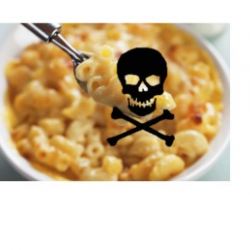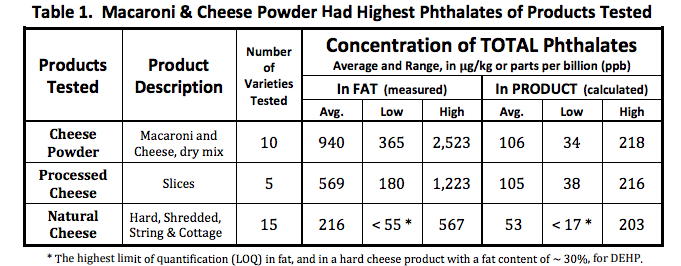
The New York Times really stepped in some cheesy goo yesterday.
An article on the "dangers" of macaroni and cheese was so insanely wrong that it's hard to believe it was in the paper at all.
The author was Roni Caryn Rabin who, although not a scientist, has written about health issues for more than 20 years. And she has done a lot of fine work. But this article was so deeply flawed and filled with scare tactics that it comes across as little more than an anti-chemical screed against a group of ubiquitous chemicals called phthalates.
I understand that screeds sell papers, especially when they are written about a group of chemicals with hard to pronounce names like "phthalates." But the easy road, rewriting a press release about a scary-sounding chemical name, is not how a top five "newspaper of record" should be trying to inform the public about health issues. Phthalates are ubiquitous by now, they have been in use for 85 years, and analytical instrumentation has become so incredibly powerful they (and most other chemicals) are detectable even in extremely low concentrations. Phthalates didn't suddenly just appear; they are simply now detectable. We are constantly bathed in thousands of chemicals that, both natural and synthetic, are carcinogenic and toxic, yet have been around in tiny amounts all along.
This cannot have been a journalist simply misunderstanding science. From the misleading and manipulative title - "The Chemicals in Your Mac and Cheese" - to the content itself, this article was designed to promote fear of chemicals. Let's look at some of the flaws and misleading statements:
"Potentially harmful chemicals that were banned from children’s teething rings and rubber duck toys a decade ago may still be present in high concentrations in your child’s favorite meal: macaroni and cheese mixes made with powdered cheese."
In reality, the study has little to do with macaroni and cheese, just its packaging. Mac and cheese was chosen because it invokes images of children. Had the authors used virtually any packaged food the story would have been the same, but "The Chemicals in Your Kale" would have sounded ridiculous, even though it is scientifically no more or less so than the title chosen. It is unlikely that this bit of sleight-of-hand was an accident.
"Now a new study of 30 cheese products has detected phthalates in all but one of the samples tested, with the highest concentrations found in the highly processed cheese powder in boxed mac and cheese mixes."
This is classic scaremongering - equating the presence of a chemical with risk - and therefore perfect media clickbait. It is a scientific given that the presence of a chemical does not equal toxicity. Presence and risk may or may not have anything to do with each other. Furthermore, this discussion is automatically meaningless without the inclusion of the dose or exposure, the inherent toxicity, and metabolic fate of the chemical. The highest concentrations had to be found in "highly processed cheese powder in boxed mac and cheese mixes." But this is not because of the processing. It is because of the box and other packaging materials—the source of the phthalates.
This becomes obvious when you examine the report itself (see table below), which had no scientists involved and was funded by litigation groups that are specifically opposed to Kraft and other makers of processed foods, such as Center for Food Safety and Center for Science in the Public Interest, all of whom make their money suing companies. While the phthalate content of cheese powder and processed cheese is similar, "natural" cheese had considerably fewer phthalates. It goes without saying that when more surface area of any food is exposed to any chemical found in wrapping, some parts per billion will be absorbed into the food, and chunks of cheese have a lesser surface area than slices or powders.
But organic shoppers can't nod their heads about industrial food. Their products had the same phthalates, because it's about boxes, not food.

Source: Coalition for Safer Food Processing and Packaging
Rabin engages in another cheap trick here.
"Phthalates are not deliberately added to food. They are industrial chemicals used to soften plastics and are used as solvents, in adhesives and in ink on packaging."
The fact that a chemical is used industrially for other purposes is immaterial when assessing its health risk. Vani Hari, the self-proclaimed "Food Babe", made the same "error" when she wrote about Subway bread containing a (harmless) chemical that is also found in rubber mats, as if that matters. The intent here seems clear—to equate, at least viscerally, a food with a non-food simply because they are made with the same chemical. The fact that phthalates are also used in adhesives and inks is totally irrelevant scientifically, but not (apparently) journalistically. Rabin either should or does know better.
The most misleading part of the article
"Although the concentration of phthalates in food may be quite low, measured in parts per billion, they are still present at higher levels than the natural hormones in the body..."
This is perhaps the single most misleading (and probably most effective) sentence in the entire article. It is obviously intended to misinform people by suggesting that the amount of a given substance in the blood relative to the amount of a hormone means anything whatsoever.
Forget New York Times hysteria, here is the science answer. It cannot.
In the absence of information on how strongly the chemical in question binds to the hormone receptor relative to the hormone itself, the fact that it binds is meaningless. The fact that both bind is not a question; the issue is how much stronger or weaker phthalates bind to estrogen receptors, and whether they block or enhance the action of estrogen.
The quantity of phthalates in food is not a valid measure (or predictor) of any possible effect upon sexual development in a living organism because:
- The amount of phthalates in food will always be greater than the amount in the body after the food is eaten, and never equal to or greater than the amount that will be in the body. The phthalates will not be 100 percent absorbed, and some of them will be metabolized and excreted.
- The phthalates themselves are not suspected estrogen mimics, but rather, some of their metabolites, which are formed in the liver.
- Some of these metabolites are present in minuscule amounts, even compared to the parent phthalate.
- It is impossible to estimate how much of a given metabolite will end up occupying an estrogen receptor based on a crude measurement of the weight of the phthalate in food. Multiple factors determine this.
- These data are based on in vitro (test tube) tests of isolated receptors. In vitro tests may or may not reflect anything that happens in the real world. Very often they do not. At best, they are surrogate measurements of what may occur in a biological system, and sometimes quite poor ones at that.
Perhaps the silliest notion here, as certain environmental groups with nothing better to do seem to want, is to magically remove phthalates from everything (good luck with that). Before you even ponder this silly idea, consider the following.
There are three substances, possibly all in your home, that are serious and potent estrogen receptor binders (aka "endocrine disruptors") and are known to elicit a physiological response in humans:
- Birth control pills
- Soy
- Marijuana
All of these will absolutely swamp any possible effect that you might (but won't) see from a box of noodles.
Now, doesn't this cheese nonsense seem rather silly? The New York Times should do way better than this.
